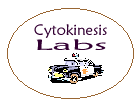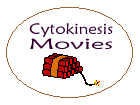|
The Mafia at ASCB 1999 |
|
12/11/1999 12/12/1999 Member: Ahna Skop Board
# B28 1:30pm Member: Brad Shuster
Board # B30 1:30pm 12/13/1999 Member: Chris O'Connell
Board # B25 12:00pm Member: Karen Oegema
Board # B68 1:30pm Member: Matthew Savoian
Board # B24 1:30pm 12/14/1999 12/15/1999 Member: Julie Brill 4:25pm
TALK See Below for Abstracts |
|
The Cleavage Furrow Protein Anillin Interacts with Myosin During Mitosis. Aaron F Straight, Christine Field, Timothy J Mitchison, Harvard Medical School, 240 Longwood Ave, Boston, MA 02115 The construction of the cleavage furrow requires the assembly of many proteins at the plane of cell division between metaphase and cytokinesis. Contractile ring assembly and cleavage furrow contraction must be tightly controlled to ensure proper chromosome segregation and cell division. We have studied the cleavage furrow protein anillin and its role in assembly of the cleavage furrow and the timing of cytokinesis. We have shown that anillin is phosphorylated during mitosis and is rapidly dephosphorylated at the metaphase to anaphase transition. Dephosphorylation of anillin coincides with anillin relocalization to the contractile ring and requires inactivation of the cyclin-B/cdc2 kinase. Anillin was isolated as a protein that bound to F-actin by affinity chromatography. However, the dephosphorylation of anillin does not change its abililty to interact with actin. In order to identify other components that interact with anillin we performed affinity chromatography with purified anillin protein. We have found several proteins that bind specifically to anillin in mitotic and interphase xenopus extracts. One of these anillin binding proteins is a nonmuscle myosin heavy chain that localizes to the contractile ring during cytokinesis. We are now determining whether the interaction between anillin and myosin is important for the assembly of the cleavage furrow and whether this interaction is regulated during the transition from mitosis to interphase.
|
|
Poster Secretion is Required to Complete Cytokinesis in Caenorhabditis elegans Ahna R Skop1, Dominique Bergmann2, William Mohler1, John G. White1,1UW-Madison, 1525 Linden Drive, 227 Bock Labs, Madison, WI 53706, 2UC-Boulder Cytokinesis is the fundamental process of cleaving a cell into two. We have shown that the final pinching off and separation of daughter cells in the C. elegans embryo requires a functional secretory pathway. We inhibited secretion in early C. elegans embryos by treatment with Brefeldin A and by suppressing expression of Rab11, a GTPase required for Golgi to plasma membrane vesicle targeting. By using multifocal plane, time-lapse recording of secretion-suppressed embryos, we showed that these treatments produced similar failures in cytokinesis: the furrow initiates and ingresses normally yet does not complete. Instead, the furrow fully regresses leaving an uncleaved multinucleated cell. We have used multiphoton microscopy in conjunction with an FM143 membrane probe to show that the furrow does not completely pinch off during these abortive, secretion-suppressed cleavages. The midzone of the mitotic spindle has been shown to be defective in mutants that exhibit failures in the terminal phase of cytokinesis. We suggest that spindle midzone microtubules are necessary for vesicle targeting to the late cleavage furrow in a manner analogous to the function of the phragmoplast microtubules of plant cell cytokinesis. Plant and animal cell cytokinesis may be fundamentally similar processes.
|
|
Poster p34cdc2 activity indirectly specifies the timing of cytokinesis in echinoderm eggs Charles B. Shuster1, David R. Burgess2, 1University of Pittsburgh, 5th and Ruskin, Pittsburgh, PA 15260, 2Boston College Using micromanipulation as well as biochemical approaches in dividing echinoderm eggs, we have sought to determine how the timing of cytokinesis is coupled to the cyclic activation and destruction of p34cdc2 activity. Biochemical analysis of myosin light chain (LC20) phosphorylation revealed that cdc2-phosphorylated LC20 was detected only on cytoplasmic (soluble) myosin. To examine whether cdc2 modulation of myosin II activity is involved in regulating the timing of cytokinesis, we asked whether cleavage furrows could be induced in cells arrested in mitosis. Cells microinjected with nondegradable cyclin B could be induced to form cleavage furrows if metaphase asters were placed in close proximity to the cortex by micromanipulation. These results indicate that the cortex is responsive to the cleavage stimulus in the presence of elevated MPF activity. Cleavage furrows could not be induced, however, in manipulated prophase or aphidocolin-arrested blastomeres, suggesting that the mere presence of asters is not sufficient to induce the spindle poles and the surface in manipulated blastomeres will further decrease the timing between anaphase onset and cleavage. Such experiments will reveal whether the timing of cytokinesis is a function of the delivery of the cleavage stimulus to the cortical cytoskeleton. Supported by GM 58231.
|
|
Poster The cytokinetic phase (C-phase) of the PtK1 mammalian tissue cell cycle: Timing and role of microtubules. Julie C. Canman, Edward D. Salmon, University of North Carolina-Chapel Hill, 607 Fordham Hall, CB# 3280, Chapel Hill, NC 27599 C-phase, which is usually initiated as cells exit mitosis, results in the physical separation of one cell into two daughter cells. It is characterized by a sequential progression of several events: furrow formation, lamellipodial activity, furrow completion, and cell respreading. In this study, we compared the timing and morphology of these C-phase events in uninjected control cells and in prometaphase cells injected with anti-Mad2p antibody. This antibody abrogates the mitotic checkpoint, inducing premature anaphase onset between 5 to 15 minutes after injection. We found that C-phase progression following sister chromosome separation in anti-Mad2p antibody injected cells was similar, if not identical, to C-phase progression in uninjected control cells which entered anaphase normally. To test if progression into C-phase requires microtubules, prophase and early prometaphase cells were treated with 10 m M nocodazole and subsequently injected with anti-Mad2p antibodies. These cells underwent cortical contractions for about 1 hour. Then, the contractions ceased and the cells respread into their interphase morphology, even in the presence of nocodazole at concentrations which abolished all microtubules. If the nocodazole was washed out 20-30 minutes after antibody injection, about 20 percent of the cells underwent cytokinesis. Thus, cells are capable of undergoing cytokinesis without previously forming a mitotic spindle, but not as efficiently.
|
|
Poster Dynein-dependent Positioning of the Mitotic Spindle in Mammalian Cells. Christopher B. O'Connell, Yu-li Wang, University of Massachusetts Medical School, 377 Plantation St., Worcester, MA 01605 In animal cells, positioning of the mitotic spindle is crucial for defining the plane of cytokinesis and the size ratio of daughter cells. We have characterized this phenomenon in a rat epithelial cell line using light microscopy, micromanipulation, and antibody microinjection. Unmanipulated cells always position the mitotic spindle near their geometric center, with the spindle axis lying roughly parallel to the long axis of the cell. Spindles that were initially misoriented underwent directed rotation and showed a significant delay in anaphase onset. To further examine this process cells were gently deformed with a blunted glass needle, which effectively changed the spatial relationship between the cortex and spindle. This manipulation induced spindle movement or rotation, depending on how the cell was manipulated, until the spindle reached a proper position relative to the deformed shape. The response was inhibited by treatment with the microtubule stabilizing drug taxol or microinjection of antibodies to the intermediate chain of dynein. Our results suggest that mitotic cells have a mechanism for monitoring and maintaining the positioning of the spindle. This process appears to be part of a mitotic check point mechanism and is dependent upon microtubules and the motor protein dynein.
|
|
Poster Analysis of a human homolog of the Drosophila cytokinesis protein anillin Karen Oegema1, Timothy J Mitchison2, Christine Field2, 1European Molecular Biology Laboratory, Meyerhofstrasse 1, Heidelberg, D-69117, 2Harvard Medical School To study cleavage furrow assembly, we identified hAnillin, a human homolog of a Drosophila actin-binding protein important for cytokinesis. Like dAnillin, hAnillin localizes to nuclei during interphase, to the cortex during mitosis, and to the cleavage furrow during cytokinesis. Microinjection of anti-hAnillin antibodies slows the rate of furrow contraction and prevents cytokinesis. To analyze its dynamic localization, we transfected GFP fusions of hAnillin fragments into BHK cells. All fusions containing the C-terminal quarter of hAnillin, including its PH domain, formed ectopic cortical foci during interphase. The septin hCDC10, but neither myosin II nor actin, localized to these ectopic foci, suggesting that anillin and the septins interact at the cortex. Cleavage furrow localization requires an additional domain homologous to the actin binding domain of dAnillin. hAnillin, hCDC10 and myosin II accumulate simultaneously in the cleavage furrow. During mitosis, both hAnillin and hCDC10 are found in cortical foci that localize along actin cables, consistent with the idea that hanillin binds to actin in vivo. During cytokinesis, hAnillin is found along cortical actin cables that are initially oriented parallel to the spindle axis; as the furrow ingresses, many actin cables become oriented parallel to the ingressing furrow.
|
|
Poster THE BEHAVIOR OF UNATTACHED CHROMATIDS AS THEY ATTACH TO THE ANAPHASE SPINDLE. Matthew S Savoian, Conly L. Rieder, Wadsworth Center, New York State Department of Health, P.O. Box 509, Albany, NY 12201-509 During prometaphase in vertebrates, an attaching kinetochore can glide poleward (P) along the surface of a microtubule at up to 55 m m/min (C.L. Rieder and S.P. Alexander, J. Cell Biol., 110:81-95, 1990). This rapid P motion is thought to be mediated by a fast microtubule minus-end motor (e.g.,cytoplasmic dynein) on the kinetochore surface. However, since rapid P motion is not seen during anaphase this fast motor is either lost or inactivated at chromatid disjunction, or its velocity limited by a governor. To differentiate between these possibilities we induced newt lung cells containing monooriented chromosomes to enter anaphase by injecting Mad2 antibody. We then followed the subsequent behavior of the 111 unattached chromatids generated by this procedure. Over half (69/111) of these chromatids ultimately attached to and moved towards a pole prior to telophase. With one exception, all moved P at 2.6 ± 0.42 m m/min, which is the normal rate of kinetochore P motion exhibited during anaphase. In one instance a chromatid positioned 15 m m from a pole at attachment, moved into that pole at ~ 9 m m/min. These results suggest that the kinetochore-associated motor responsible for rapid P motion during prometaphase becomes non-functional at anaphase onset. Currently we are investigating the structural and immunological changes that occur in unattached kinetochores after anaphase onset.
|
|
Poster LvsA is a large cytosolic protein that is required for proper cleavage furrow morphology in Dictyostelium. Noel Gerald, Eunice Kwak, Denis Larochelle, Kalpa Vithalani, Arturo De Lozanne, Duke University In a screen for essential cytokinesis genes, we isolated a novel gene called large volume sphere A (lvsA). Cells with mutations in lvsA become large and multinucleate in suspension culture due to a defect in cytokinesis. Instead of maintaining a single equatorial furrow, lvsA- cells attempting division in suspension develop two abnormally placed constrictions that cause the cell equator to swell. Interestingly, this phenotype resembles Clathrin null cells as they fail to divide in suspension. This suggested that LvsA might have a role in membrane trafficking during cytokinesis. Antibodies raised to a C-terminal fragment of LvsA protein recognize the predicted 400kDa full-length product in wildtype cell lysates. This 400kDa product does not appear in lvsA- lysates, which suggests that this cell line may be a true null. To examine the role of the LvsA protein in cytokinesis, we used homologous recombination to introduce GFP at the 5' end of lvsA. Cells expressing GFP-LvsA are able to grow in suspension, demonstrating that the protein is functional. Surprisingly, preliminary results indicate that GFP-LvsA remains cytosolic throughout cytokinesis and other stages of the cell cycle. Biochemical fractionation experiments confirm that the 400kDa LvsA product does not associate with membranous organelles, but remains in the cytosolic fraction.
|
|
Poster The Mechanism of Flagellar Length Control: Intraflagellar Transport Balances Retrograde Tubulin Flux Wallace F Marshall, Joel L Rosenbaum, Yale University, 266 Whitney Ave., New Haven, CT 06520 A major question in cell biology is how cells determine size. Chlamydomonas flagella provide a convenient and genetically tractable system to study size regulation of organelles. Mutants in a kinesin, FLA10, have short flagella, suggesting FLA10-driven intraflagellar transport (IFT) is needed to maintain flagellar length, possibly by balancing ongoing protein turnover. We have developed a pulse-labeling assay to visualize flagellar microtubule turnover in situ. We find that new tubulin is continually assembled onto the distal ends of flagellar outer-doublet microtubules at steady-state, and simultaneously tubulin appears to undergo retrograde flux towards the base at a rate of 0.05 microns/min. This suggest treadmilling, with tubulin assembling at the distal end of the doublets while disassembling from the base of the flagellum. The apparent treadmilling rate exactly equals the resorption rate in fla10 mutants shifted to restrictive temperature, and pharmacological treatments that arrest tubulin flux rescue the fla10 defect, suggesting IFT is needed to support constant assembly at the distal tip thereby balancing the retrograde flux. These results explain the need for IFT, reveal the functional basis of a flagellar length mutant, and lead to a model for length regulation whereby length-dependent assembly is balanced by length-independent disassembly, robustly maintaining a unique stable length.
|
|
Talk The four wheel drive PI 4-kinase regulates intercellular bridge formation during Drosophila male meiosis.
Developing germ cells in many organisms undergo a specialized form of cytokinesis in which cell separation is incomplete and daughter cells remain connected by intercellular bridges called ring canals. To identify regulators of cytokinesis and ring canal assembly, we exploited the powerful molecular genetics of Drosophila melanogaster and the well-characterized cytology of male germ cell differentiation in this organism. Wild-type function of the four wheel drive (fwd) gene is required for conversion of contractile rings into stable ring canals during male meiosis. Early stages of cytokinesis are normal in fwd mutant males, yet cleavage furrows are unstable, and daughter cells fuse together after each meiotic division to form multinucleate spermatids. The fwd phenotype, which abolishes male fertility, is associated with two defects late in meiotic cytokinesis: abnormal organization of actin filaments and failure to accumulate phosphotyrosine epitopes that mark normal ring canals. To explore the molecular basis of fwd function, we cloned the gene and identified its predicted product as a phosphatidylinositol 4-kinase (PI 4-kinase) type III b . PI 4-kinases perform the first committed step in the pathway that produces the important regulatory molecule PIP2. We propose that fwd exerts its effect on cytokinesis and ring canal assembly by regulating interactions between the actin cytoskeleton and the plasma membrane via PIP2.
|






